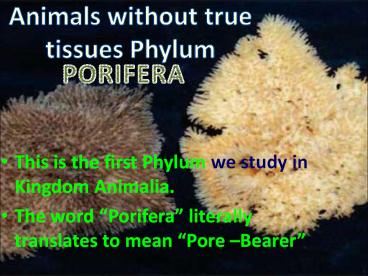This is the first Phylum we study in Kingdom Animalia. - PowerPoint PPT Presentation
1 / 11
Title:
This is the first Phylum we study in Kingdom Animalia.
Description:
This is the first Phylum we study in Kingdom Animalia. The word Porifera literally translates to mean Pore Bearer Sessile, majority are marine. – PowerPoint PPT presentation
Number of Views:147
Avg rating:3.0/5.0
Title: This is the first Phylum we study in Kingdom Animalia.
1
Animals without true tissues Phylum
PORIFERA
- This is the first Phylum we study in Kingdom
Animalia. - The word Porifera literally translates to mean
Pore Bearer
2
SPONGES in GENERAL
- Sessile, majority are marine.
- Once thought to be plants
- No true tissues or organs
- Specialized cells Choanocytes, Porocytes,
Amoebocytes. - No nervous or muscles tissue
3
FILTER FEEDING
- Collar cells (Choanocytes) line the inside of the
sponges body. - Flagellum of these collar cells create a current
to bring water into the sponge. - Water carries food for the sponge.
- Water exits through the top of the sponge this is
called the OSCULUM.
4
(No Transcript)
5
(No Transcript)
6
Special Cells or Structures in Sponges
- Collar cells (Choanocytes) flagellated aid in
digestion. - Amoebocytes also aid in digestion, can move
around in the wall of the sponge! - Spicules a structural material glasslike
makes the sponge very distasteful for things that
might want to eat it.
7
Reproduction
- Sponges are hermaphrodites
- They produce both male and female gametes but
only one at a time. - When the egg is fertilized the zygote develops
into a free-swimming larva. - The larva attaches to the bottom and undergoes
metamorphosis to become a mature sponge. - Sponges can also reproduce asexually by branching
or budding, and some freshwater sponges form use
GEMMULEformation.
8
Ecological Role of Sponges
- Shelter smaller organisms
- Symbiosis with bacteria and plantlike protists
provide food and oxygen and remove wastes. - Recycle calcium trapped in coral and shells
amoebocytes release special chemicals in
digestion. - Research into sponge chemicals for new medicines
and much needed antibiotics.
Purple Tube Sponge Colony on Dead Coralhead
atRainbow Reef near Bimini, The Bahamas
9
(No Transcript)
10
(No Transcript)
11
Well meet Squidward later on in the course !































